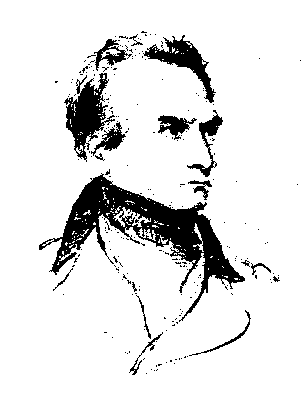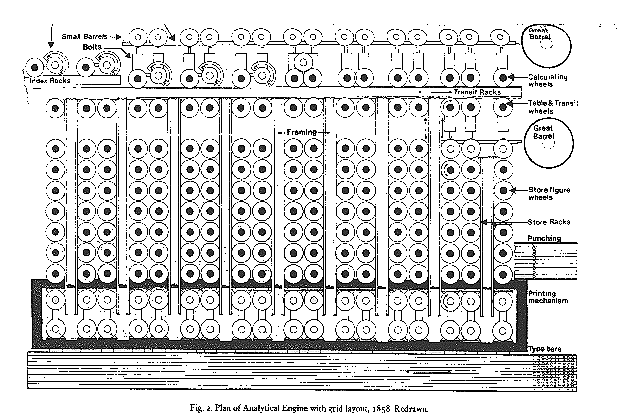But I would here give attention to a remarkable illustration of natural law
which has been brought forward by Mr. Babbage, in his Ninth Bridgewater Treatise.
The reader is requested to suppose himself seated before the calculating machine,
and to observe it. It is moved by a weight, and there is a wheel which revolves
through a small angle around its axis, at short intervals, presenting to his
eye successively, a series of many numbers engraved on its divided circumference.
Let the figures thus seen be the series, 1, 2, 3, 4, 5, &c., of natural
numbers, each of which exceeds its immediate antecedent by unity.
"Now, reader," says Mr. Babbage, " let me ask you how long
you will have counted before you are firmly convinced that the engine has
been so adjusted, that it will continue, while its motion is maintained, to
produce the same series of natural numbers? Some minds are so constituted,
that, after passing the first hundred terms, they will be satisfied that they
are acquainted with the law. After seeing five hundred terms few will doubt,
and after the fifty thousandth term the propensity to believe that the succeeding
term will be fifty thousand and one, will be almost irresistible. That term
will be fifty thousand and one; and the same regular succession will continue;
the five millionth and the fifty millionth term will still appear in their
expected order, and one unbroken chain of natural numbers will pass before
your eyes, from one up to one hundred million.
"True to the vast induction which has been made, the next succeeding
term will be one hundred million and one; but the next number presented by
the rim of the wheel, instead of being one hundred million and two, is one
hundred million ten thousand and two. The whole series from the commencement
being thus,-
• 1
• 2
• 3
• 4
• 5
• ...
• ....
• .....
• 99,999,999
• 100,000,000
• regularly as far as 100,000,001
• 100,010,002 the law changes.
• 100,030,003
• 100,060,004
• 100,100,005
• 100,150,006
• 100,210,007
• 100,280,008
• ... ... ...
• ... ... ...
" The law which seemed at first to govern this series failed at the hundred
million and second term. This term is larger than we expected by 10,000. The
next term is larger than was anticipated by 30,000, and the excess of each
term above what we had expected forms the following table:-
• 10,000
• 30,000
• 60,000
• 100,000
• 150,000
• ... ...
• ... ...
• being, in fact, the series of triangular numbers,* each multiplied by 10,000.
* The numbers 1, 3, 6 10, 15, 21, 28, &c. are formed by adding the successive
terms of the series of natural numbers thus:
• 1= 1
• 1+2= 3
• 1+2+3= 6
• 1+2+3+4=10, &c. They are called
" If we now continue to observe the numbers presented by the wheel, we
shall find, that for a hundred, or even for a thousand terms, they continue
to follow the new law relating to the tri- angular numbers; but after watching
them for 2761 terms, we find that this law fails in the case of the 2762d
term.
" If we continue to observe, we shall discover another law then coming
into action, which also is dependent, but in a different manner, on triangular
numbers. This will continue through about 1430 terms, when a new law is again
introduced which extends over about 950 terms, and this, too, like all its
predecessors, fails, and gives place to other laws, which appear at different
intervals.
" Now it must be observed that the law that each number presented by
the engine is greater than the preceding number, which law the observer
had deduced from an induction of a hundred million instances, was not the
true law that regulated its action, and that the occurrence of the number
triangular numbers, because a number of points corresponding to any term can
always be placed in the form of a triangle; for instance-
.
. ..
. .. ...
. .. ... ....
1 3 6 10
100,010,002 at the 100,000,002nd term was as necessary a consequence of the
original adjustment, and might have been as fully foreknown at the commencement,
as was the regular succession of any one of the intermediate numbers to its
immediate antecedent. The same remark applies to the next apparent deviation
from the new law, which was founded on an induction of 2761 terms, and also
to the succeeding law, with this limitation only- that, whilst their consecutive
introduction at various definite intervals, is a necessary consequence of
the mechanical structure of the engine, our knowledge of analysis does not
enable us to predict the periods themselves at which the more distant laws
will be introduced."
 Many
innovations and important creations are attributed to his genius including his machines performing mathematical calculations (called Calculating Engines)
and the ambitious Analytical Engines projects, which were flexible punch-card
controlled general calculators, he created a Table of logarithms of the
natural numbers from 1 to 108000 which was a standard reference from 1827
through the end of the century. Babbage pioneered many other technical innovations
as well as developing mathematical code breaking.
Many
innovations and important creations are attributed to his genius including his machines performing mathematical calculations (called Calculating Engines)
and the ambitious Analytical Engines projects, which were flexible punch-card
controlled general calculators, he created a Table of logarithms of the
natural numbers from 1 to 108000 which was a standard reference from 1827
through the end of the century. Babbage pioneered many other technical innovations
as well as developing mathematical code breaking.  (1837), for example, argued that natural laws were capable
of explaining so-called miracles. Miracles were not, argued Babbage, evidence
of the succession of natural laws, but might merely be evidence of a higher
or greater law of which we had heretofore been ignorant. The
(1837), for example, argued that natural laws were capable
of explaining so-called miracles. Miracles were not, argued Babbage, evidence
of the succession of natural laws, but might merely be evidence of a higher
or greater law of which we had heretofore been ignorant. The